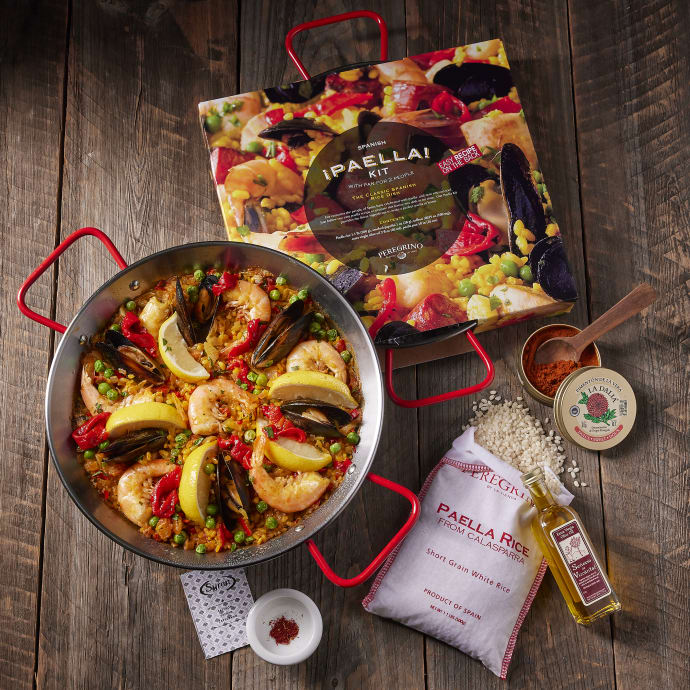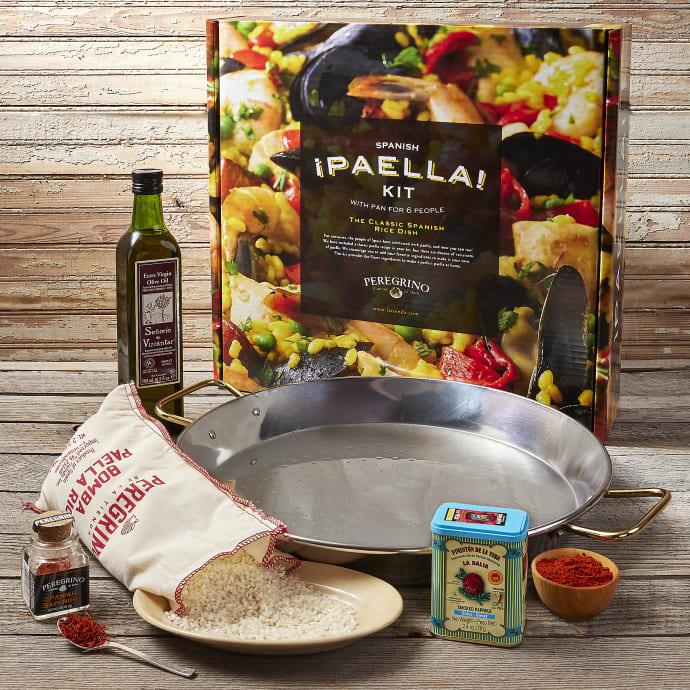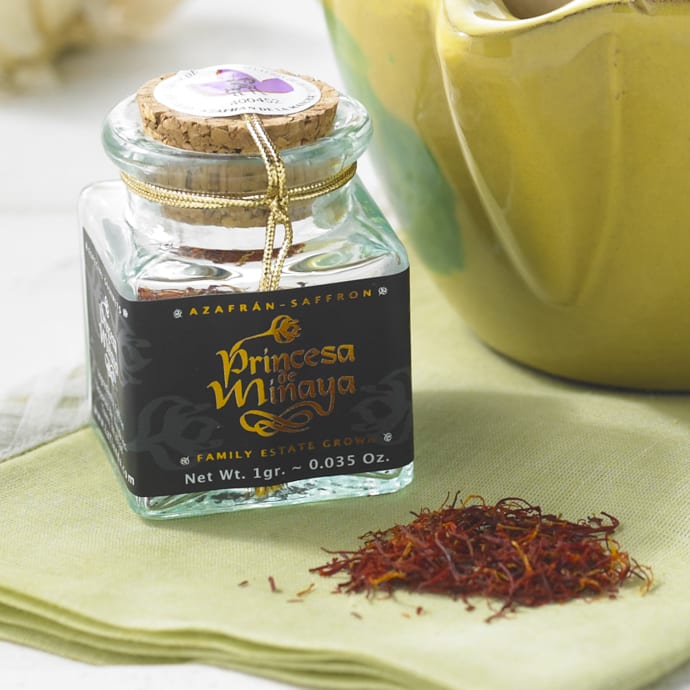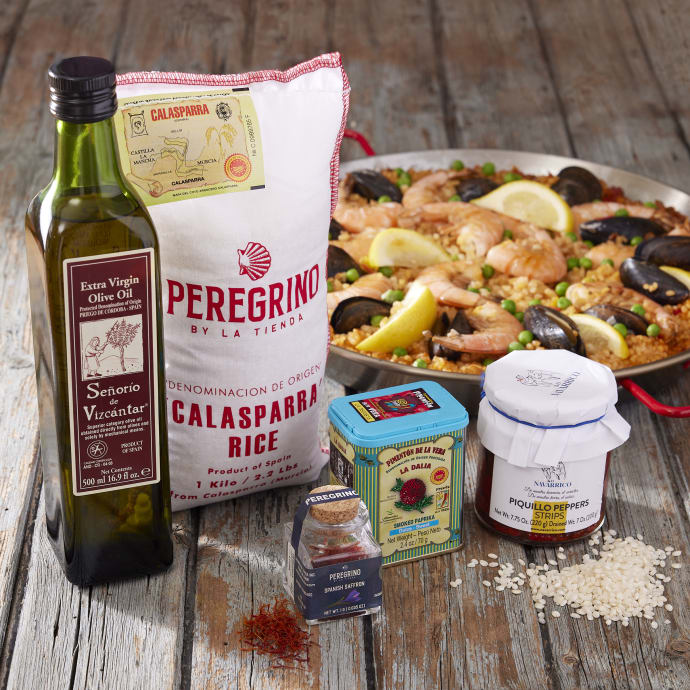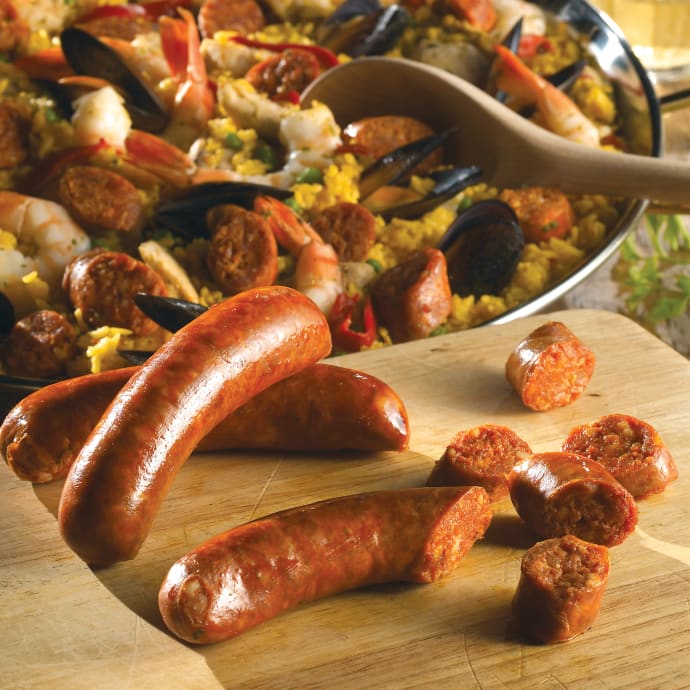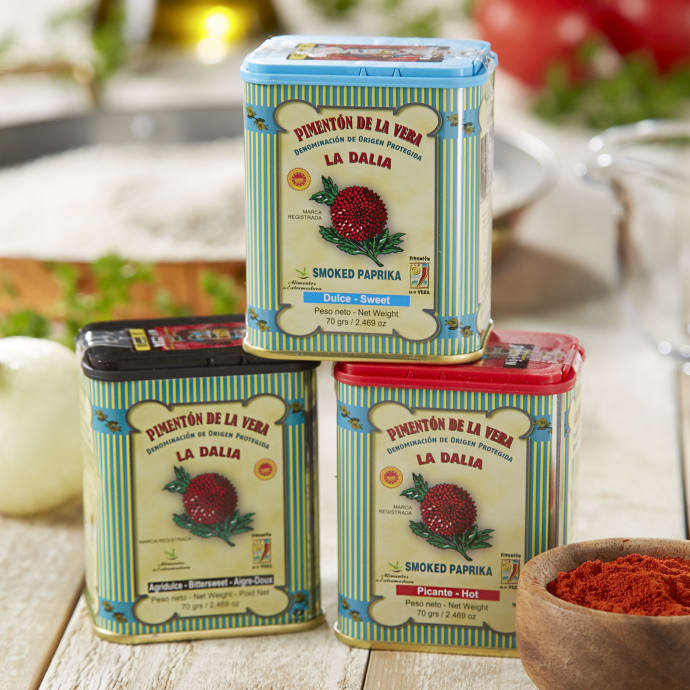
Soul of Spanish cooking
The Washington Times
-
May 30, 2007
Richard Slusser
As paella is all about rice, there is one type that is preferred: the short-grained variety produced in the vast rice fields south of Valencia between the Mediterranean and the mountains. The favorite is the bomba variety, which cracks around the middle like an accordion instead of from top to bottom. Mr. Andres says that Calasparra rice from Spain or arborio from Italy may be used instead -- but in Valencia, bomba is the rice of choice for paella.
Besides bomba, there are two other rices that can be certified and marketed as "arroz de Valencia" as a designation of origin under the rules of a regulatory council: senia and bahia, which are both medium-grain. These are Valencia's big three, preferred over the world's more than 5,000 other rices.
The Valencian rices -- about one-third of the Spanish crop -- are produced in the flat fields of the Albufera, a freshwater lake in a national park of the same name. The Albufera is a haven for migratory birds as well as a recreational area for the city and surrounding municipalities.
The lake and sea are separated by the Dehesa del Saler, a narrow six-mile-long stretch of land, much of it sand dunes held in place by Mediterranean pines, shrubs and grasses. The lagoon was formed in prehistoric times by sediment from two rivers, the Turia to the north and the Jucar to the south. At some points, the lake is four miles wide.
Within the Albufera is El Palmar, founded in 1250 by King Jaume I the Conqueror, who granted the local residents a charter allowing them to fish in the lagoon. In El Palmar, local fishing boats can be hired to tour the lake, passing through many channels and pausing for a rice dish for lunch on the boat. Along the seacoast are broad sandy beaches:
Paella a la Valenciana is the most famous, for it was in the Valencia area east of Madrid on Spain's Mediterranean coast that the Moors introduced rice as a crop and developed an irrigation system that made it possible to grow this water-demanding cereal. Some say this happened in the 11th century, but most sources claim that rice production dates from the eighth century.
Valencia's other rice dishes include arroz a banda, made with fish stock; arroz al forno, rice baked with chickpeas, tomato and sausage; arroz con alubias y nabos, which is soupy and includes turnips and white beans; and olleta, a pumpkin and chestnut rice with pork and vegetables.
A favorite non-rice dish in Valencia is fideua, which is similar to a paella and includes seafood but is made with pasta. Cookbook author Teresa Barrenechea suggests substituting small elbow macaroni or angel-hair pasta broken into 2-inch lengths for the Valencian pasta.
The Spanish word for rice is just one of the many Arabic words that have become part of Spanish and other languages: arroz in Spanish from arruz in Arabic. Azafran, the Spanish word for saffron, is another almost direct copy from Arabic, and, like the rice, is essential to a paella. Albufera is from the Arabic word for lake.
Paella evolved from a humble dish cooked over a fire by people working in the orange groves -- as in Valencian oranges. In "The Cuisines of Spain, Exploring Regional Home Cooking" (Ten Speed Press), Miss Barrenechea disputes the claim that "paella" comes from "paelleria," the steel (but not stainless) pan in which it is cooked. The pan, with low sides, has two handles.
Miss Barrenechea says paella "comes from the Latin patella, the term for the large, round dish the Romans used for presenting their gifts to the gods. Apparently the paella pan as we know it today -- and what defines a paella from other rice dishes -- came many centuries after the name was first used."
It has been said that paella is a man's dish and is best made by men, but I have found that many Spanish men happily praise mother's paella. When a man is cooking paella, odds are that he will be doing it outdoors over a wood fire, for a truly traditional paella. When it is done, it must be served immediately -- or some prefer to let it rest briefly to get a bit crustier.
There are two schools about whether the rice should be put directly in the pan with the broth or whether the rice should be sauteed first -- apparently to open the grains for absorbing more flavors.
Paellas are not covered and sometimes are cooked in pans that can fit over two burners on a stove. Food writer Florence Fabricant suggests, instead, that two paellas be prepared in pans that will each fit over one burner, perhaps one seafood, the other meats.
Miss Fabricant provides the recipe Eric Ripert's Seafood Paella, in "The New York Times Country Weekend Cookbook," just published by St. Martin's Press. Mr. Ripert, the chef at Le Bernadin in New York City, cooks paella for guests at his home in Sag Harbor, N.Y.
A seafood paella would use fish stock in place of the chicken broth used for paellas with meat.
Miss Fabricant says a paella should not be attempted "without the proper pan and the proper rice."
She advises using 1/3 to 1/2 cup of rice per person. "Usually twice the quantity of liquid as rice is needed."
Paella pans often are stocked by grocers for Latino communities, and they are available on the Internet, but remember that stainless steel is not the preferred paelleria. Paella pans carried by gourmet shops tend to be much more expensive than the authentic pans available at La Tienda (phone 800/710-4304 or visit www.tienda.com) which stocks Spanish paella pans from 16 inches to 36 inches in diameter.
The saying that half the diameter of a pan indicates how many people a paella made in that pan will serve is not always true. An 8-inch paella pan serves one person, a 10-inch pan will serve two; the 36-inch pan will serve 40 to 50 persons, according to La Tienda.
Paella de pollo y setas (Chicken and mushroom paella)
This recipe by Jose Andres is from his book "Tapas: A Taste of Spain in America."
"In this paella," Mr. Andres says, "you can add some extra vegetables like eggplant, zucchini, cauliflower or any of your favorite vegetables. Just saute the vegetables after the chicken. You can also add chicken livers for extra flavor, or substitute rabbit for the chicken."
Other combinations also work, such as the addition of chorizo, the spicy Spanish sausage. In Valencia, morcilla, the Spanish blood sausage, often is used along with chicken or other meats.
-2 tablespoons Spanish extra-virgin olive oil
-2 chicken legs, cut into small pieces
-8 ounces seasonal fresh mushrooms, whole (such as chanterelles)
-3 ounces green beans, cleaned and cut into 1-inch pieces
-½ garlic clove, finely chopped (about 1 teaspoon)
-2 tablespoons of jamon serrano (Spanish dry cured ham), cut into small cubes
-1/4 cup white wine
-1/4 cup sofrito (recipe follows)
-4 cups chicken stock
-1 pinch saffron
-1 bay leaf
-1 tablespoon salt
-1½ cups Spanish bomba rice, or arborio (Italian)
In a paella pan over high heat, saute the chicken with the olive oil until it's very brown on every side, about 4 minutes. Remove and set aside.
Add the mushrooms and saute until they are golden, about 3 minutes. Add the green beans and the garlic, and cook for 3 minutes. Return the chicken to the pan along with the ham.
Pour in the white wine and allow it to reduce by half, about 1 minute. Add the sofrito and cook for 3 minutes. Pour in the chicken stock and bring to a boil. Crush the saffron and add to the pan along with the bay leaf. Season with the salt. Make sure it's just a little salty, because when we add the rice, the dish will balance itself out.
Add the rice, taking care to spread it evenly around the pan. Cook for 5 minutes on a high flame, stirring frequently with a wooden spoon. You'll see the rice floating around the pan. If it's not, add an extra ½ cup of stock or water.
Reduce the heat to low and maintain a slow boil for an additional 10 minutes, until the liquid is absorbed. Never put your finger or spoon into the paella again or the rice will cook unevenly.
Let sit for 3 minutes. At this stage, the stock has been absorbed by the rice and there's a nice shine to the top of the paella. Serve immediately. This makes generous servings for 4 or more.
SOFRITO (CATALAN TOMATO AND ONION SAUCE)
-10 ripe plum tomatoes
-1½ cups Spanish extra-virgin olive oil
-4 small Spanish onions, peeled and finely chopped (about 4 cups)
-1 teaspoon sugar
-1 teaspoon salt
-1 teaspoon pimenton dulce (Spanish sweet paprika)
-1 bay leaf
Cut the tomatoes in half. Place a grater over a large mixing bowl. Rub the open face of the tomatoes over the grater until all the flesh is grated. Discard the skin.
Heat the oil in a medium saucepan over a medium-low flame. Add the onions, the sugar and salt. Cook, stirring occasionally with a wooden spoon, until the onions become soft and tender and turn a light brown color, about 45 minutes. You want the onions to caramelize. If they get too dark, add ½ tablespoon of water to keep them from burning while they cook.
Add the reserved tomato puree, the pimenton, and bay leaf. Cook for another 20 minutes over medium heat. You'll know your sofrito is ready when the tomato has broken down and deepened in color and the oil has separated from the sauce.
As paella is all about rice, there is one type that is preferred: the short-grained variety produced in the vast rice fields south of Valencia between the Mediterranean and the mountains. The favorite is the bomba variety, which cracks around the middle like an accordion instead of from top to bottom. Mr. Andres says that Calasparra rice from Spain or arborio from Italy may be used instead -- but in Valencia, bomba is the rice of choice for paella.
Besides bomba, there are two other rices that can be certified and marketed as "arroz de Valencia" as a designation of origin under the rules of a regulatory council: senia and bahia, which are both medium-grain. These are Valencia's big three, preferred over the world's more than 5,000 other rices.
The Valencian rices -- about one-third of the Spanish crop -- are produced in the flat fields of the Albufera, a freshwater lake in a national park of the same name. The Albufera is a haven for migratory birds as well as a recreational area for the city and surrounding municipalities.
The lake and sea are separated by the Dehesa del Saler, a narrow six-mile-long stretch of land, much of it sand dunes held in place by Mediterranean pines, shrubs and grasses. The lagoon was formed in prehistoric times by sediment from two rivers, the Turia to the north and the Jucar to the south. At some points, the lake is four miles wide.
Within the Albufera is El Palmar, founded in 1250 by King Jaume I the Conqueror, who granted the local residents a charter allowing them to fish in the lagoon. In El Palmar, local fishing boats can be hired to tour the lake, passing through many channels and pausing for a rice dish for lunch on the boat. Along the seacoast are broad sandy beaches:
Paella a la Valenciana is the most famous, for it was in the Valencia area east of Madrid on Spain's Mediterranean coast that the Moors introduced rice as a crop and developed an irrigation system that made it possible to grow this water-demanding cereal. Some say this happened in the 11th century, but most sources claim that rice production dates from the eighth century.
Valencia's other rice dishes include arroz a banda, made with fish stock; arroz al forno, rice baked with chickpeas, tomato and sausage; arroz con alubias y nabos, which is soupy and includes turnips and white beans; and olleta, a pumpkin and chestnut rice with pork and vegetables.
A favorite non-rice dish in Valencia is fideua, which is similar to a paella and includes seafood but is made with pasta. Cookbook author Teresa Barrenechea suggests substituting small elbow macaroni or angel-hair pasta broken into 2-inch lengths for the Valencian pasta.
The Spanish word for rice is just one of the many Arabic words that have become part of Spanish and other languages: arroz in Spanish from arruz in Arabic. Azafran, the Spanish word for saffron, is another almost direct copy from Arabic, and, like the rice, is essential to a paella. Albufera is from the Arabic word for lake.
Paella evolved from a humble dish cooked over a fire by people working in the orange groves -- as in Valencian oranges. In "The Cuisines of Spain, Exploring Regional Home Cooking" (Ten Speed Press), Miss Barrenechea disputes the claim that "paella" comes from "paelleria," the steel (but not stainless) pan in which it is cooked. The pan, with low sides, has two handles.
Miss Barrenechea says paella "comes from the Latin patella, the term for the large, round dish the Romans used for presenting their gifts to the gods. Apparently the paella pan as we know it today -- and what defines a paella from other rice dishes -- came many centuries after the name was first used."
It has been said that paella is a man's dish and is best made by men, but I have found that many Spanish men happily praise mother's paella. When a man is cooking paella, odds are that he will be doing it outdoors over a wood fire, for a truly traditional paella. When it is done, it must be served immediately -- or some prefer to let it rest briefly to get a bit crustier.
There are two schools about whether the rice should be put directly in the pan with the broth or whether the rice should be sauteed first -- apparently to open the grains for absorbing more flavors.
Paellas are not covered and sometimes are cooked in pans that can fit over two burners on a stove. Food writer Florence Fabricant suggests, instead, that two paellas be prepared in pans that will each fit over one burner, perhaps one seafood, the other meats.
Miss Fabricant provides the recipe Eric Ripert's Seafood Paella, in "The New York Times Country Weekend Cookbook," just published by St. Martin's Press. Mr. Ripert, the chef at Le Bernadin in New York City, cooks paella for guests at his home in Sag Harbor, N.Y.
A seafood paella would use fish stock in place of the chicken broth used for paellas with meat.
Miss Fabricant says a paella should not be attempted "without the proper pan and the proper rice."
She advises using 1/3 to 1/2 cup of rice per person. "Usually twice the quantity of liquid as rice is needed."
Paella pans often are stocked by grocers for Latino communities, and they are available on the Internet, but remember that stainless steel is not the preferred paelleria. Paella pans carried by gourmet shops tend to be much more expensive than the authentic pans available at La Tienda (phone 800/710-4304 or visit www.tienda.com) which stocks Spanish paella pans from 16 inches to 36 inches in diameter.
The saying that half the diameter of a pan indicates how many people a paella made in that pan will serve is not always true. An 8-inch paella pan serves one person, a 10-inch pan will serve two; the 36-inch pan will serve 40 to 50 persons, according to La Tienda.
Paella de pollo y setas (Chicken and mushroom paella)
This recipe by Jose Andres is from his book "Tapas: A Taste of Spain in America."
"In this paella," Mr. Andres says, "you can add some extra vegetables like eggplant, zucchini, cauliflower or any of your favorite vegetables. Just saute the vegetables after the chicken. You can also add chicken livers for extra flavor, or substitute rabbit for the chicken."
Other combinations also work, such as the addition of chorizo, the spicy Spanish sausage. In Valencia, morcilla, the Spanish blood sausage, often is used along with chicken or other meats.
-2 tablespoons Spanish extra-virgin olive oil
-2 chicken legs, cut into small pieces
-8 ounces seasonal fresh mushrooms, whole (such as chanterelles)
-3 ounces green beans, cleaned and cut into 1-inch pieces
-½ garlic clove, finely chopped (about 1 teaspoon)
-2 tablespoons of jamon serrano (Spanish dry cured ham), cut into small cubes
-1/4 cup white wine
-1/4 cup sofrito (recipe follows)
-4 cups chicken stock
-1 pinch saffron
-1 bay leaf
-1 tablespoon salt
-1½ cups Spanish bomba rice, or arborio (Italian)
In a paella pan over high heat, saute the chicken with the olive oil until it's very brown on every side, about 4 minutes. Remove and set aside.
Add the mushrooms and saute until they are golden, about 3 minutes. Add the green beans and the garlic, and cook for 3 minutes. Return the chicken to the pan along with the ham.
Pour in the white wine and allow it to reduce by half, about 1 minute. Add the sofrito and cook for 3 minutes. Pour in the chicken stock and bring to a boil. Crush the saffron and add to the pan along with the bay leaf. Season with the salt. Make sure it's just a little salty, because when we add the rice, the dish will balance itself out.
Add the rice, taking care to spread it evenly around the pan. Cook for 5 minutes on a high flame, stirring frequently with a wooden spoon. You'll see the rice floating around the pan. If it's not, add an extra ½ cup of stock or water.
Reduce the heat to low and maintain a slow boil for an additional 10 minutes, until the liquid is absorbed. Never put your finger or spoon into the paella again or the rice will cook unevenly.
Let sit for 3 minutes. At this stage, the stock has been absorbed by the rice and there's a nice shine to the top of the paella. Serve immediately. This makes generous servings for 4 or more.
SOFRITO (CATALAN TOMATO AND ONION SAUCE)
-10 ripe plum tomatoes
-1½ cups Spanish extra-virgin olive oil
-4 small Spanish onions, peeled and finely chopped (about 4 cups)
-1 teaspoon sugar
-1 teaspoon salt
-1 teaspoon pimenton dulce (Spanish sweet paprika)
-1 bay leaf
Cut the tomatoes in half. Place a grater over a large mixing bowl. Rub the open face of the tomatoes over the grater until all the flesh is grated. Discard the skin.
Heat the oil in a medium saucepan over a medium-low flame. Add the onions, the sugar and salt. Cook, stirring occasionally with a wooden spoon, until the onions become soft and tender and turn a light brown color, about 45 minutes. You want the onions to caramelize. If they get too dark, add ½ tablespoon of water to keep them from burning while they cook.
Add the reserved tomato puree, the pimenton, and bay leaf. Cook for another 20 minutes over medium heat. You'll know your sofrito is ready when the tomato has broken down and deepened in color and the oil has separated from the sauce.
Other Press
Holiday Gift Guide 2024: The Finest Spanish Olive Oils For A Taste Of Spain
Forbes
-
November 26, 2024
A trio of savory snacks to enjoy this fall
Atlanta Journal-Counstitution
-
November 1, 2024
The 15 Best Gifts for People Who Love Food
Wirecutter
-
October 23, 2024
The 48 Best Gifts for Dads
Wirecutter
-
October 16, 2024
Featured Products
 SHIPS FREE
SHIPS FREEMini Paella Kit with Pan in Gift Box by Peregrino - FREE SHIPPING!
PA-10
(32)
$69.00$69.00

Deluxe Paella Kit with Stainless Pan by Peregrino
PA-07
(6)
$199.00$199.00

Princesa de Minaya Saffron, D.O. La Mancha
SN-09
(53)
$25.00$25.00
 BEST SELLER
BEST SELLEREssential Paella Ingredients
PA-05
(31)
$69.00$69.00
 BEST SELLER
BEST SELLERBomba Paella Rice by Peregrino
RC-03
(108)
$22.00$22.00
 BEST SELLER
BEST SELLERArtisan Cooking Chorizo Sausage by Peregrino
CZ-50
(75)
$22.00$22.00

15 Inch Traditional Steel Paella Pan - Serves 6
PP-07
(33)
$27.00$27.00

Smoked Paprika Trio by La Dalia
PK-12
(52)
$19.00$19.00

